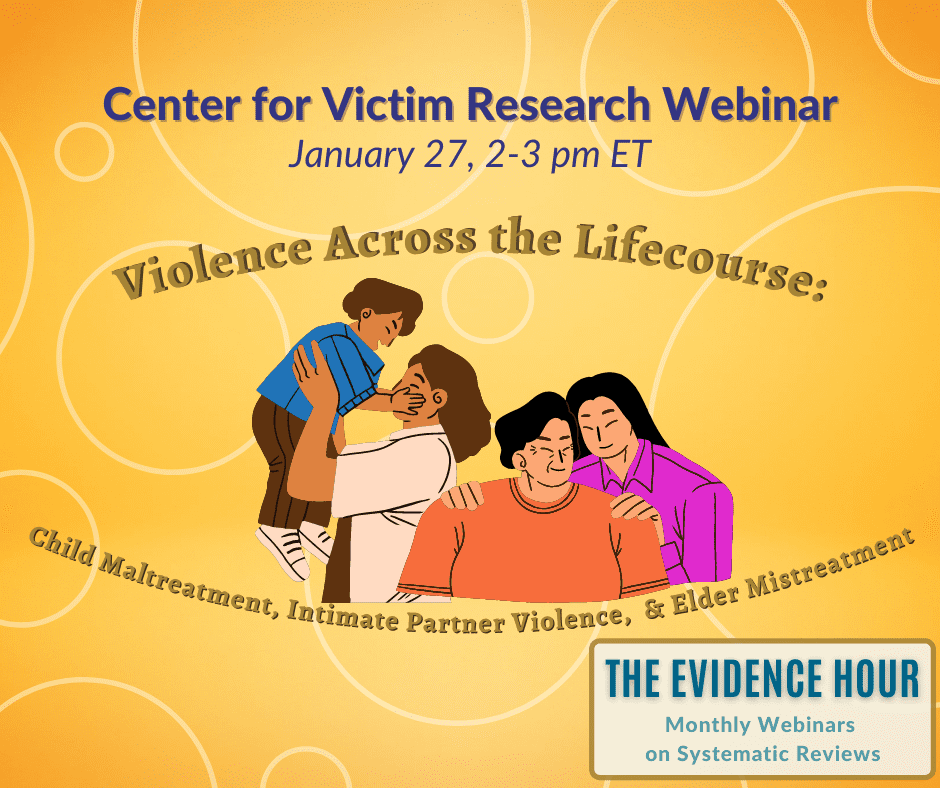The Evidence Hour: Violence Across the Lifecourse – Child Maltreatment, Intimate Partner Violence, and Elder Mistreatment

The Center for Victim Research’s webinar series, The Evidence Hour, showcases a recent systematic review* or meta-analysis about victimization, trauma, or victim services. Each webinar features an author of the research and a practitioner discussant who will review the findings and reflect on what they mean for victim service providers and researchers.
Todd I. Herrenkohl, Ph.D. discussed findings from the literature review about the developmental associations between child maltreatment, violence in adolescence, and intimate partner violence (IPV) and elder mistreatment. Karen A. Roberto, Ph.D. reviewed the existing, though limited, evidence on the close association between adult IPV and elder mistreatment. They noted what is known about the persistence of violence in and across family and other interpersonal relationships, noting where gaps in knowledge remain and where research is particularly strong. Sandy Bromley, JD, discussed applying this research, such as providing survivors’ time and space to talk about previous experiences of violence to preventing further violence in communities by deploying psychoeducational resources after a violent event. All presenters talked about risk and protective factors and emphasized that “violence is not inevitable.”
This webinar is based on findings from the article: “Child Maltreatment, Youth Violence, Intimate Partner Violence, and Elder Mistreatment: A Review and Theoretical Analysis of Research on Violence Across the Life Course” by T. I. Herrenkohl et al. (2022). Trauma, Violence, & Abuse, 23(1), 314–328. (Email the Research Librarian for full-text.)
Related Research:
- “Addressing the victim–offender overlap: Advancing evidence-based research to better service criminally involved people with victimization histories” by S.M. Bucerius et al. (2020): Victims & offenders, 16(4):1-16. This study involved interviews and surveys with 266 people incarcerated in Canada and included a focus on their victimization histories. Nearly all participants (men: 96%; women: 97%) reported experiencing frequent victimization, a much higher percentage than that of the general population in Canada. Most participants had experienced repeated violence from a young age and before their first arrest. The researchers also noted that most victims had not disclosed their victimization to anyone before; when asked why, participants said things like: “never really thinking about reporting,” to “not wanting to be a snitch,” “not knowing how to,” to “no one would have believed me,” to “feeling ashamed about being victimized,” to “not growing up in an environment where you would report to police because you take matters in your own hands/low trust in police.” (p. 8) during interviews, women “often normalized physical and sexual violence against them to a greater degree than men.” (p. 9). Using these findings, a Victim Services worker outlined resources for prisoners and met with people one-on-one to navigate access to services. The worker also trained correctional officers on referring individuals for help and went into the community to meet with people released from prison about their needs.
- “Recognizing the cumulative burden of childhood adversities transforms science and practice for trauma and resilience“ by S. Hamby et al. (2021). American psychologist, 76(2), 230. This paper summarizes the evolution of Adverse Childhood Experiences (ACEs) research, including increased knowledge about cumulative disadvantage, polyvictimization, and trauma beyond the families. The researchers also discuss how trauma interacts with risk factors, from psychological and physical health to social connections to structural inequities and how these mechanisms can contribute to adversity later in life. The researchers share the need to tap into “wisdom about resilience and pathways to thriving despite adversity” (p. 238), like developing people’s sense of purpose, prosocial acts, and mindfulness to reduce symptoms and increase meaning-making. The paper emphasize the need for future research and practice to pay more attention to racial trauma and ongoing oppressions to address the full scope of trauma and resilience. (See also other papers from this special issue of the American Psychologist)
- “Shifting the lens: An implementation study of a community-based and social network intervention to gender-based violence.” by M.E. Kim. (2021). Violence against women, 27(2), 222-254. This paper summarizes research about the shift from providing individual victim services to engaging the community in healing from and preventing gender-based violence. The researcher also describes a pilot intervention model in California, Creative Intervention, where change agents (those most affected by violence) lead the intervention and lean on each other for support and ideas and prioritizes responding to marginalized communities’ needs. Table 1 includes a chart comparing conventional approaches, innovative approaches and similar innovative models. The article outlines a survey conducted with multiple organizations about their knowledge, importance placed, commitment, and organizational readiness to implement the Creative Intervention, challenges to adopting the model, and the steps they took to implement parts of the model post-test.
Related Resources from our Research2Practice Network:
- Esperanza United: Te invito/Engaging Men and Boys Toolkit and Organizational Capacity Building Toolkit for involving more community members in preventing violence and strengthening service providers’ workforce and connections to their communities.
- National Adult Protective Services Association and National Committee for the Prevention of Elder Abuse Research Committee: Child Adversities, Midlife Health, and Elder Abuse: Application of Cumulative Disadvantage Theory to Understand Late Life Victimization for additional research on the connections between ACEs and abuse in later life and what can be done to intervene and prevent further trauma.
- National Resource Center on Domestic Violence: Building Comprehensive Solutions to Domestic Violence for training in victim-defined advocacy and considering survivors’ and children’s safety and working with partners who batter.
- National Resource Center for Reaching Victims: Reaching Victims Who Have an Incarceration History (webinar) and Returning and Healing Toolkit for working with survivors returning to their communities after incarceration.
*What are Systematic Reviews?
- A systematic review is the process of bringing together all available studies about a well-defined question, analyzing the quality of their study methods, and summarizing their findings.
- Systematic reviews often use a statistical practice called meta-analysis. This means combining data from multiple studies, to find patterns and calculate the average effect of the intervention.
- Because systematic reviews pool results from many experiments and rate the methods of each study, these reviews increase our confidence in the quality and consistency of the evidence and what it means for the field.
Basically, systematic reviews take a large amount of information about a complex issue from multiple sources and make that information more manageable and usable. These reviews can also help make sense of conflicting findings from different studies.
Learn more from:
- Quick Reference: Systematic Reviews
- Quick Reference: Tips on Reading Research Articles
« PREVIOUS NEXT »

FOLLOW US